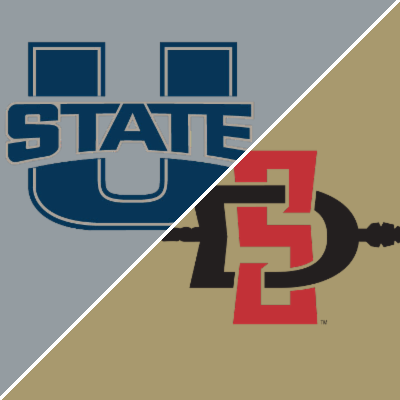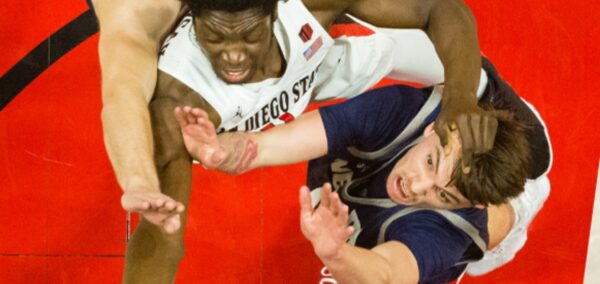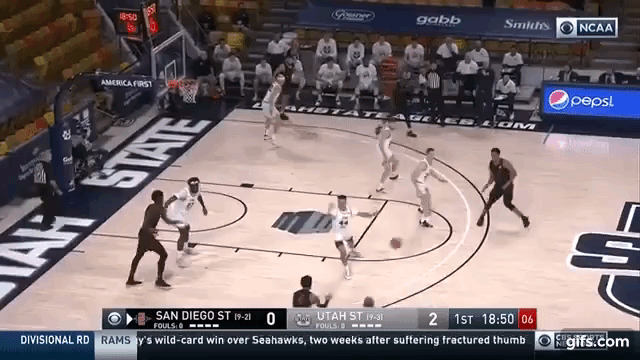Takeaways for SDSU from the Utah State series

NCAA Logo

The Aztecs took a couple of hard losses on the road against Utah State.
In the first game, they looked completely outmatched, couldn’t get the offense going, and ended with Matt Mitchell getting injured. The second game looked better. The bench stepped up, Lamont Butler had a breakout performance, and it was a close game with 2:00 left. The Aztecs just couldn’t hit the shots to end the game.
Losing the series is tough and hurts the Aztecs’ ability to get quality wins.
They currently stand at 1-2 in quad 1 games. Depending on how well Boise St. does, the next shot for a quad 1 win might be in the conference tournament.
What did we learn from the series?
1. Where does the offense go from here?
Last week I talked about how the offense should focus more on posting up rather than running pick and rolls. The overall data for the season suggests it’s a good idea. Analytics, in general, don’t like post-ups. They’re inefficient to score out of. Passing out of post-ups can be very effective, though, and for this season’s Aztecs team, they’ve accounted for the most efficient plays of the season.
In the last series, I mentioned how the offense started to take shape by running through the post. The Aztecs should do that because the guards aren’t great at creating shots for themselves or others. For example, in the series against Nevada, they ran 37 post-ups, and 39 pick and roll plays. In the first game against Utah State, the Aztecs ran only 11 post-ups and 28 pick and roll plays, leading to their worst offensive performance in years. The Aztecs don’t have many players who can consistently create for themselves or others out of a pick and roll. Nathan Mensah is learning to create for himself down low, and Matt Mitchell can create from anywhere but is more effective when he’s in the post, and he can draw fouls rather than commit them.

For at least the next two weeks, the problem with this theory is that Matt Mitchell will be gone. His abilities down low created a lot of that efficiency, both as a scorer and passer. Matt Mitchell hyperextended his knee in the first game of the series and is expected to miss at least two weeks.
With Mitchell out, the team loses the best creator on a team devoid of them. Nathan Mensah has improved as a scorer out of the post but isn’t ready to be the first option. That means the team has to go back to focusing on pick and rolls.
Trey Pulliam is a solid passer but isn’t aggressive or skilled enough to consistently create the advantages out of the pick and roll that open up the passing lanes. Gomez is a skilled scorer, but his small stature makes it hard to get the separation required to get his shots or open those passing lanes. Seiko is a 3 and D player, Schakel is a more skilled 3 and D player. The options to create shots are slim, to say the least.
Enter Lamont Butler.
The freshman had a breakout game in the second game of the series, finishing with 13 points (on 8 shots) and 5 steals. He showed a lot of aggression driving to the rim on Saturday and was a big reason the Aztecs kept the game so close despite missing their best player. No play showed his potential better than his drive to the rim with 2:30 left in the second half, where he snaked the pick and roll, up faked Neemias Queta, and hit a layup while drawing a foul for an And-1. It was Queta’s 5th foul of the game.
How about @lamont_butler1 … 11 pts, 5 stls, 2 boards. #GoAztecs pic.twitter.com/lcixI7NfMH
— San Diego State Men's Basketball (@Aztec_MBB) January 16, 2021
Before getting too excited, Butler shouldn’t be expected to solve all the problems. On the season, he boasts a 0.5 Assist-to-Turnover ratio, and even in his breakout game, he had only one assist and three turnovers. He showed an ability to get to the rim that none of the other guards have, though. That ability can hopefully be leveraged into more assists. With another good game or two, Butler may play himself into a starting role. Even if it doesn’t happen this season, the future at the point guard spot looks bright for the Aztecs.
2. Nathan Mensah needs to work on his hands.
Nathan Mensah is a great player. After the Nevada series, I proclaimed him the MVP of the team. That being said, everyone can work on their game. Mensah has had a problem that has plagued him since his first days on campus. He’s a big strong dude, but that strength doesn’t translate to his hands for some reason. Many times in the first game, Mensah had the ball stripped while attempting a shot or even just sizing up his opponent.

It shouldn’t be that easy to do. It’s not just a one-game thing either, although no one has exposed it as much as Queta did. All game, Mensah struggled just to catch the ball, and when he would attack the basket, he had the ball stripped, leading to 5 turnovers in game 1. He only had one turnover in game 2 but got blocked at the rim trying to lay the ball in rather than dunk it on multiple occasions. It affects his rebounding, too, as he will be in position for a board and not be able to secure it.
On paper, Mensah was the best Aztec in game 1. He led the team in both points and rebounds, with 13 and 9, respectively. He also had an impact on slowing down Neemias Queta and Utah State’s overall effectiveness.
With Keita on and Mensah off: Utah state +10 in a 12 pt game. Pretty simple adjustment for Saturday. I’m actually really surprised this WASN’T the game plan. @aztecbreakdown with the stats! https://t.co/emuveShL5o
— Kyle K. (@CallMeKinslow) January 15, 2021
Game 2 was a different story, but Coach Dutcher said the altitude negatively impacted him. That won’t be the case in most games for the rest of the season.
The Aztecs need him on the floor at his best, but it’s hard to reach your potential when you struggle to catch and contain the ball. Making a conscious effort to hold the ball and dunk the ball rather than lay it in should help with some turnover problems.
3. Looking to the future
The bad news first. As previously mentioned, Matt Mitchell will be out for at least two weeks. The offense was starting to take shape around his ability to draw fouls and score in the post. He had also been taking the responsibility of guarding the opponent’s best perimeter player in the end of close games, as he did against Grant Sherfield in the Nevada series. Without Mitchell, the team will need a lot of guys to step up and fill those roles.
The Aztecs also sit at 3-3 in the Mountain West, which is good for 5th place as of Saturday night. Boise St. and Utah St. are tied for first with 8-0 records. The Aztecs need to start playing above .500 to stay in the top 5 and get a first-round bye in the conference tournament.
Now for the good news. The Aztecs showed a lot of heart against a good Utah St. team while missing their best player.
All things considered this was a positive outcome for SDSU, yes losing sucks. But you are playing at altitude against a very good team without your best player. Lamont’s emergence and Keshad’s better than usual defense stood out to me.
— B-L-M, Anthony is a bully, Dante Exum fan account (@advancedstats23) January 16, 2021
The team needs more creators. With Mitchell gone, someone will be forced to take on that role. It will give a player like Gomez, or Butler, or even Mensah more game time opportunities. Nothing is a given, but if those players can start to get into a rhythm while Mitchell is out, then the team will be more dangerous when he comes back as they’ll have more offensive options. They’ll also be forced to hone their defense and make it as good as it can be. It is currently the 20th best defense in the nation, according to KenPom. The Aztecs’ best teams have always been defensively focused. In both games against Utah State, they played good defense. It’s just a matter of finding how to get consistent offense.
In addition to getting younger guys an opportunity to step up, the Aztecs had the hardest part of the conference schedule at the front. The next ten games are against Air Force, Wyoming, New Mexico, San Jose St., and Fresno St. Those are all winnable games. The hardest series will likely be Air Force on the road, due to elevation, the unique offense Air Force likes to run, and Matt Mitchell’s absence. A mostly bench unit almost beat Utah St., though, so two wins against Air Force is definitely doable. The Aztecs can use this stretch to get healthy and build some momentum. It’s not out of the realm of possibility to be 13-3 on February 24th, heading into a series against Boise St. Hopefully, they can ride that momentum to success against Boise St. and into the postseason.
Native San Diegan living in Montana. Big time Aztec Basketball fan. Creator of Aztec Breakdown. Hoping to help people enjoy basketball more by increasing their understanding of it.